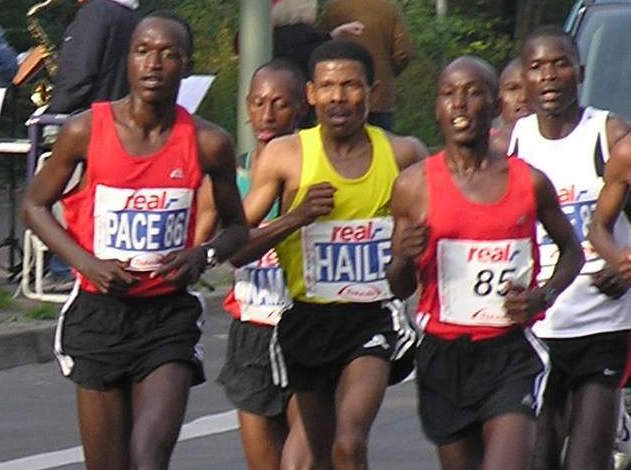I spend some of my free time in Washington DC’s Rock Creek Park, bicycling or hiking. This slender gem winds its way through the northwest sector of the nation’s capital for five miles, following the aptly named Rock Creek. Heavily wooded, the park is a haven for urban hikers and runners seeking a scenic route and relief from the summer heat or the winter wind.
I’ve noticed a significant number of what appear to be East African runners using the winding, hilly dirt trails for training runs. Their body type and facial features tend to betray their region of origin. With their smooth, easy stride, they seem to glide over the terrain almost effortlessly at top speed. As we pass each other on the trail, I typically get a smile and an accented “hello,” as if he or she were taking a casual stroll instead of keeping a pace that would have me wheezing after a few hundred meters.
East Africans, mostly Kenyans and Ethiopians, have dominated competitive long distance running for decades. One measure of their dominance is the Boston Marathon, where 25 of the last 28 male champions have been from Kenya or Ethiopia. More recently, the women have gotten into the act, winning 17 of the last 19. The reasons behind their domination have been the subject of much study and speculation – a subject too complicated to address here – but it is likely a combination of physiological, environmental, and cultural factors. Pictures of strength, form, and grace, the sight of these magnificent athletes running is truly a thing of beauty.
One thing that every ambulatory child in the world has in common is running. For most children, the running begins as soon as walking is mastered. Many childhood outdoor games involve running – indeed it is difficult to think of many that don’t involve running. Running is an activity that transcends cultural and economic differences; every healthy child can do it and it costs nothing. In many cultures, especially those less affluent or rural, running is a necessary part of daily life as the most practical form of personal transport.
In my own childhood, before the days of home video games and hundreds of cable channels, outdoor play that involved running was a nearly everyday activity. Games and sports such as tag, red rover, football and baseball filled our days. In the woods at the edge of our development, we imagined that we were great Native American deer hunters, chasing our fleet prey through the forest with a spear or bow and arrow.
The running was most often done in the context of a game or sport, but sometimes running itself was the activity. A geographic area that was largely our daily world was circumscribed by ½ mile long “block” of roads that had little vehicular traffic. Occasionally a group of us, bored with our regular play, would race around this block. The older kids leading the way, we sprinted down the hills and struggled up them. With burning lungs we completed the course in one final kick, fancying ourselves Olympic champions finishing the mile or the marathon. Each of us would collapse after crossing the finish line, scattering ourselves across someone’s front lawn, giving it the appearance of a bloodless crime scene. After a few minutes somebody, usually one of the older boys, might get up and announce “going again”, and take off. Those of us with enough air in our lungs would struggle to our feet and stagger off in pursuit.
Back then I found running to be an exciting spectator sport as well. Track and field meets were much more in the public’s sports consciousness back then. Everyone knew who the top runners in the world were, with Americans always in the mix. To this day, whenever I pass a high school track meet or cross-country race in progress, I have the urge to stop and watch for a little while.
Though built more for sprinting than distance running, as an adult I enjoyed competing in the shorter distance races and in any sport that involved running. In the home stretch of these races, as I pushed myself to the limit, I was once more the Native American hunter or chasing the older boys through the neighborhood.
Time and injury eventually took their toll, and I struggled to keep running despite a series of orthopedic issues. I’ll never forget a follow-up examination that I had with the doctor after my fourth knee surgery. As he wrote down some notes, I anxiously asked when I could start running again. He looked up with surprise and said, “Oh, we’re way past that, now.”
So now I ride my mountain bike and hike the trails of Rock Creek Park to stay fit, hoping that someday the stars will align and my knees will permit me to start running again. And I hope to run one more race – just to do it. Just to retire by choice, on my own terms.
On these hikes, I encounter runners of all ages and types: ground-pounders just starting to run for better health, average folks trying to stay in shape, and experienced racers. I give each of them a smile or nod as we pass each other, making enough room on the trail to allow them to pass. But when these East African runners approach, I step off of the trail completely and turn and watch them pass. I watch with wonder, until they are out of sight. At least I can still do that.
 Thought Widget get learnt
Thought Widget get learnt





Roberto, that was a captivating story and you created some vivid images of the present and the past. I too enjoy the simplicity of running, the freedom of getting outdoors, and a personal challenge to keep up a good pace. Happy trails to you!
Thank you. Happy running!
Bravo
Thank you Sheamus, I’m glad you enjoyed it!